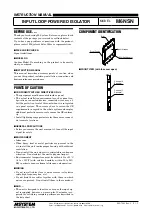
ENGINEERING MANUAL OF AUTOMATIC CONTROL
SMOKE MANAGEMENT FUNDAMENTALS
180
Another consideration in zone pressurization is that bringing
in outdoor air at low temperatures can cause serious freeze
damage. Provision should be made to prevent damage when
using outdoor air, such as providing emergency preheat and
minimizing the quantity of outdoor air used.
Testing of smoke control strategies should include not only
verification of acceptable pressures but also confirmation that
interaction with other systems creates no problems, such as
excessive door pull in a stairwell pressurization system (refer
to American with Disabilities Act).
Typical Operation for Zone Pressurization System (Fig. 6):
1. Smoke detector(s) initiate alarm in specific zone.
2. System switches to smoke control mode as determined
in remote control panel.
3. System turns on pressurization fans if not already on.
4. System allows pressurization fans to continue running if
supply duct smoke detector is not in alarm or manual
override is not activated.
5. System enables damper operation as appropriate for
smoke control mode.
6. Operator verifies operation as appropriate (e.g., action
of differential pressure switch).
7. Operator cancels smoke control mode as long as initiating
panel is not in alarm and FSCS is not in manual override.
STAIRWELL PRESSURIZATION CONTROL
The objective of stairwell pressurization is to provide an
acceptable environment within a stairwell, in the event of a
fire, to furnish an egress route for occupants and a staging area
for firefighters. On the fire floor, a pressure difference must be
maintained across the closed stair tower door to ensure that
smoke infiltration is limited. Also, adequate purging must be
provided to limit smoke density caused by temporary door
openings on the fire floor.
To ensure proper stairwell pressurization system design, a
means should be included to modulate either the supply or the
exhaust/relief dampers. Also, a means should be included to
provide multiple supply injection points at a minimum of every
three floors (unless design analysis can justify a greater spacing)
to provide uniform pressurization.
According to NFPA 92A, Recommended Practice for Smoke
Control Systems, the intake of supply air should be isolated
from smoke shafts, roof smoke and heat vents, and other
building openings that might expel smoke from the building in
a fire. Wind shields should be considered at fan intakes.
Open-loop control of pressurization is seldom acceptable
because of significant pressure differences caused by door
openings. Closed loop or modulation provides the ability to
control pressurization within acceptable limits. Closed loop
control can be as simple as a barometric pressure damper
(Fig. 8) to relieve pressure at the top of a stairwell or a more
complex system to modulate dampers or fans at multiple
injection points (Fig. 9) in response to differential pressure
measurements at these points.
ROOF
LEVEL
BAROMETRIC
PRESSURE
DAMPER
OUTDOOR
AIR
INTAKE
EXTERIOR
WALL
C5151
STAIRWELL
ROOF
LEVEL
MODULATING
DAMPER
(4 PLACES)
C5152
DUCT
SHAFT
DUCT
CENTRIFUGAL
FAN
STAIRWELL
Fig. 8. Stairwell Pressurization with Barometric
Pressure Damper to Vent to the Outside.
Fig. 9. Stairwell Pressurization with Modulating Dampers
and Multiple Injection Points to Regulate Pressure.
Testing of stairwell pressurization systems should be
conducted with agreed on conditions including:
— Number and location of doors held open
— Outside pressure conditions known
— Maximum door pull force allowed
Typical Operation for Stairwell Pressurization (Fig. 6):
1. Any fire alarm initiates smoke control mode.
2. System turns on pressurization fans.
3. System allows pressurization fans to continue running if
supply duct smoke detector is not in alarm or manual
override is not activated.
Summary of Contents for AUTOMATIC CONTROL SI Edition
Page 1: ...AUTOMATIC CONTROL for ENGINEERING MANUAL of COMMERCIAL BUILDINGS SI Edition ...
Page 4: ...ENGINEERING MANUAL OF AUTOMATIC CONTROL iv ...
Page 6: ...ENGINEERING MANUAL OF AUTOMATIC CONTROL vi ...
Page 46: ...ENGINEERING MANUAL OF AUTOMATIC CONTROL CONTROL FUNDAMENTALS 36 ...
Page 66: ...ENGINEERING MANUAL OF AUTOMATIC CONTROL PSYCHROMETRIC CHART FUNDAMENTALS 56 ...
Page 128: ...ENGINEERING MANUAL OF AUTOMATIC CONTROL ELECTRIC CONTROL FUNDAMENTALS 118 ...
Page 158: ...MICROPROCESSOR BASED DDC FUNDAMENTALS 148 ENGINEERING MANUAL OF AUTOMATIC CONTROL ...
Page 208: ...ENGINEERING MANUAL OF AUTOMATIC CONTROL BUILDING MANAGEMENT SYSTEM FUNDAMENTALS 198 ...
Page 493: ...INDEX ENGINEERING MANUAL OF AUTOMATIC CONTROL 483 INDEX ...
Page 506: ...ENGINEERING MANUAL OF AUTOMATIC CONTROL INDEX 496 NOTES ...
Page 507: ...INDEX ENGINEERING MANUAL OF AUTOMATIC CONTROL 497 NOTES ...
Page 508: ...ENGINEERING MANUAL OF AUTOMATIC CONTROL INDEX 498 NOTES ...
Page 509: ...INDEX ENGINEERING MANUAL OF AUTOMATIC CONTROL 499 NOTES ...
Page 510: ...ENGINEERING MANUAL OF AUTOMATIC CONTROL INDEX 500 NOTES ...
Page 511: ...INDEX ENGINEERING MANUAL OF AUTOMATIC CONTROL 501 NOTES ...
Page 512: ...ENGINEERING MANUAL OF AUTOMATIC CONTROL INDEX 502 NOTES ...
















































